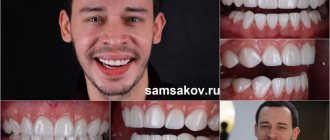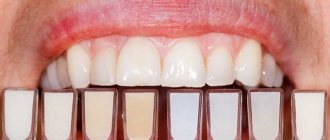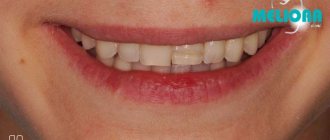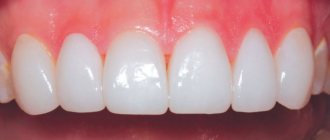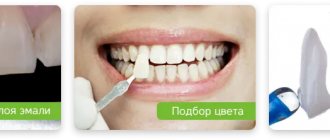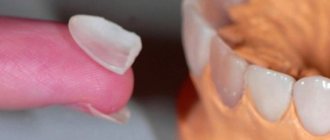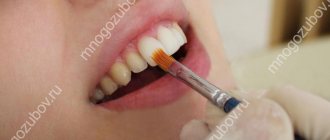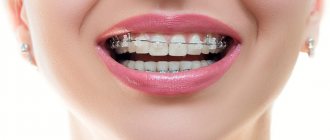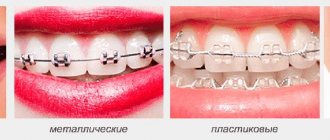A direct veneer is a microprosthesis applied in layers to the front surface of the tooth to give the required shape and color. It is created in the patient’s oral cavity immediately on the tooth from a light-activated filling composite material.
Direct veneers do not cure dental diseases. Its goal is to create an aesthetically beautiful appearance by correcting the color of the enamel or the shape of the tooth surface.
Veneers
The direct method is used to restore one or two teeth in the frontal group. They are not placed on posterior molars. When restoring a large number, other correction methods are used.
ATTENTION! For a full aesthetic appearance, it is recommended to simultaneously restore 10 front teeth on the lower and upper jaws.
Therapeutic (straight) onlays are used for minor defects:
- presence of interdental space;
- uneven teeth;
- small chip;
- darkening of tooth enamel when whitening does not give the required result;
- there are old fillings on the vestibular surface that create an unaesthetic appearance;
- slight curvature of the position in the row;
- increased tooth wear.
What are composite veneers and their composition
Composite (direct) veneers are special overlays on the front surface of the teeth, which are made from composite materials in the patient’s mouth. The reflective material is applied in layers directly to the surface of the teeth. One visit to the dentist is enough to complete the procedure.
A composite is a spatial three-dimensional combination of two or more chemical substances, in which there is a clear interface - it can be seen even with the naked eye. This combination enhances the properties of each component several times.
The first composite materials entered the dental market in 1964, but since then they have evolved, becoming more convenient and safer for humans, because during this period:
- new adhesives were created;
- the color scheme was improved;
- the strength of materials increased.
The main components of a modern composite:
- polymer matrix consisting of:
- polymerization inhibitor, which increases the shelf life of the substance;
- main and additional catalyst;
- activator;
- an ultraviolet absorber that prevents the color of the linings from changing when exposed to sunlight;
- inorganic filler, thanks to which:
- the aesthetic properties of microprostheses are increased, since the mineral filler has physical characteristics close to natural teeth;
- material deformation is prevented;
- the hardness and resistance of the composite increases;
- Surfactants or silanes are organosilicon compounds that increase the strength of the material.
Of these three components, the properties and differentiation of the composite are most influenced by fillers, which are classified based on the following characteristics:
- according to the material:
- from quartz;
- from silicon dioxide;
- from diamond dust;
- made of barium glass;
- According to the size of filler particles, there are composites from 0.04 to 45 microns;
- by particle shape:
- sticks;
- antennae;
- spirals;
- shavings;
- dust;
- ground.
Most dental composites used to make veneers are primarily composed of ground barium glass particles, but much depends on the manufacturer.
Price question: how much does it cost to install veneers?
As we already said, dental veneers are not cheap, but they are worth it!
Approximate cost of microprostheses:
- Composite ones are the most budget-friendly. The cost of one unit is approximately 7 thousand rubles;
- Ceramic microprostheses, which are manufactured in a dental laboratory, cost approximately 20 thousand rubles per unit;
- Ceramic dental veneers made at the 32 Dent clinic will cost the patient about 15 thousand rubles per unit;
- Lumineers are the most expensive - from 50 thousand rubles per unit.
Classification of composite onlays for teeth
Composite veneers are classified based on the number and size of particles they contain. According to this criterion, composite linings are divided into:
- cheap veneers with large composite particles (more than 30 microns): they quickly fade and cannot be further processed;
- overlays with mini-filler and particles up to 1.5 microns;
- hybrid composite veneers with particles measuring about 1 micron;
- microprostheses with microparticles (up to 0.04 microns), used exclusively to restore the aesthetic appearance of the front teeth.
Is it possible to replace an old veneer with a new one?
There is no exact service life and replacement time for old linings. The shade of the existing plates simply changes or their surface becomes leaky, and caries begins under the composite (if ceramics are installed, the development of caries is practically excluded). The clinic removes the old structure, the cost of the procedure is 3900 rubles per tooth. And a replacement is immediately selected for them.
There are frequent requests from patients who once had composite veneers installed, but today they would like to change them to ceramic ones, including those made using CEREC technology. Emax veneers are of ideal quality and speed of production. A new Cerec veneer can be obtained in 1.5 hours, and such veneers do not require an adjustment period.
How to create a Cerec overlay:
- The enamel is processed and the tooth is scanned. No cast needed.
- A three-dimensional model of the overlay is created taking into account the physical data.
- An automatic machine turns a prosthesis from an array of pressed ceramics.
- The veneer should be tried on and fixed.
If questions arise or the shade does not match, a corrected copy will be received within a few minutes. But such cases are rare. Veneers are ideally fixed even on uneven teeth - if the installation work is carried out by an experienced specialist. The perfect fit of the plates prevents bacteria and food particles from getting under the lining.
Indications for installation
Veneers made of composite material perfectly mask the following dental defects:
- abnormal shape of teeth;
- dental chips;
- wide spaces between teeth;
- uneven contours of the front teeth;
- displacement of crowns in the vertical plane;
- yellow or gray spots on the enamel that cannot be bleached;
- age-related change in enamel shade;
- thinning teeth;
- defect of the filling material: change in color of the filling, slight chipping;
- increased wear of crowns.
The installation of veneers is indicated if it is necessary to visually correct the condition of several teeth in the smile area. But in case of significant defects, it is more advisable to use other dental methods for correcting the dentition.
Kinds
Veneers are classified according to the material used to make them. According to this criterion, they are divided into two large groups - ceramic and composite. There are other classification parameters:
- Installation method.
- Functional features.
- Manufacturing technology.
According to these criteria, it is customary to distinguish direct, semi-direct and indirect veneers.
Direct
They are made directly in the dentist's chair. The doctor grinds the tooth to the required thickness, and then applies filling material in layers. The advantage of the method is the speed of tooth restoration. But it requires jeweler’s precision from the doctor, since he is required to restore not only the shape of the tooth, but also its color and translucency.
Semi-straight
As a rule, they are made from composite materials using a plaster cast. At the appointment, the doctor prepares the tooth and takes an impression of it. Then a model is made from the impression. Based on the model, composite veneers are made, which are then fixed to the surface of the teeth. The advantage of semi-straight structures is greater durability and accuracy compared to straight ones.
Indirect
Made from ceramic or zirconium dioxide in a dental laboratory. Just like with semi-direct veneers, the dentist first prepares the tooth and takes an impression of it. Since manufacturing takes time, temporary acrylic onlays are installed to protect the ground teeth from exposure to the environment. After the permanent microprostheses are ready, the patient comes for a second appointment.
Composite
Direct and semi-direct veneers are made from composite materials. This method is suitable if the tooth enamel is slightly damaged, there are chips, cracks, and unevenness. In some cases, composite veneers are used to correct the color of tooth enamel.
Ceramic
Ceramic veneers are always made in a dental laboratory and are installed using the indirect method. Two types of materials are used for their manufacture:
- Porcelain. They are quite durable and look natural. There are two ways to make veneers from medical porcelain. In the first method, a layer of material is applied to the tooth and then fired. In the second case, a microprosthesis is made from an impression, hardening occurs under the influence of high temperature and pressure. The disadvantage of medical porcelain is its fragility. This type of veneer can be easily damaged.
- Zirconium dioxide. This material is very durable, but the cost of zirconium veneers is significantly higher than porcelain veneers. In most cases, only the base of the structure is made from zirconium dioxide. Then ceramics are applied to it in layers. Manufacturing takes place on fully automated equipment using a 3D model. The advantage of zirconium veneers is high strength, aesthetics and biocompatibility.
- Glass ceramics. They are made using the IPS Empress system. There are absolutely no metals in the design of the elements; the material used is pressed glass ceramics. They are highly aesthetic; after installation, the prosthesis is absolutely invisible in the mouth. Another advantage of glass-ceramic products is their high strength.
- Lumineers. This type of ceramic microprosthesis is very thin and yet durable. They are made from a 3D model in the USA. Therefore, the installation period from the moment the patient first contacts until the lumineers are ready usually takes a long time. The advantage of lumineers is the ability to install without preparing the tooth. Therefore, if necessary, the structure can be easily removed. In Europe, they produce an analogue of lumineers - ultraneers.
Dentistry for those who love to smile
+7
Make an appointment
Contraindications for installation
Direct veneering is contraindicated in the following cases:
- insufficient oral hygiene, as there is a high risk of developing caries directly under the linings;
- the presence of carious cavities;
- malocclusion and the need to wear braces;
- the presence of inflammatory processes in the mouth;
- bruxism;
- tooth mobility;
- erupting wisdom tooth;
- the presence of pulpless dental units, as they are more prone to destruction;
- serious enamel defects.
If the listed pathologies are eliminated, anyone can get direct composite veneers, and they will last for quite a long time.
Reviews
If you read reviews of direct veneers from the websites Otzovik and IRecommend , you can be convinced of the short service life of the structure. After several years of wearing a photopolymer overlay, it is still necessary to install a ceramic veneer, as chipping and tarnishing are inevitable. Straight cladding deteriorates especially quickly among smokers and coffee drinkers, because... absorb brown pigment.
The integrity and wearing period of direct veneers also greatly depends on the bite . People with straight bites usually leave negative reviews of direct composite veneers because... quickly chop off the extended cutting edge. With normal and distal occlusion, on the contrary, the linings can be worn longer, because the load on the upper front teeth is minimal.
The chosen material is also important. The best results in terms of strength and aesthetics are shown by the latest generation materials - nanohybrid composites with a high degree of filling and low shrinkage. These are photopolymers such as:
- Estelite (Japan);
- Enamel plus (Italy);
- Filtek (USA).
When choosing a doctor, make sure that he has previously used the direct composite veneer method; for this, ask for a portfolio of work. After completing the procedure, do not forget to follow the recommendations: give up bad habits, do not gnaw hard foods with your front teeth.
Also, in the first week after installation, you should completely give up tea, coffee, juices , because... It is at this time that dyes from the oral cavity are most absorbed. If chips occur, you should contact the same doctor, who will carry out restoration free of charge during the warranty period (1 year).
Advantages and disadvantages of veneering
The main advantages of composite veneers include:
- speed of production and installation: you don’t even need to make additional impressions;
- durability subject to proper use and quality care;
- beautiful appearance;
- maximum naturalness: modern composite materials transmit light well.
But composite veneers also have disadvantages:
- relative fragility, which manifests itself if a person does not take care of the pads and does not use suitable personal hygiene products;
- slight masking ability, which manifests itself in the presence of teeth that are too dark in color or bright, prominent spots (due to tetracycline);
- the need to grind down the enamel: after removing the veneers, the teeth need to be restored.
If only the central and lateral incisors are restored using veneering, then the remaining teeth often have to be whitened.
The quality of installation of veneer microprostheses depends on the skill of the dentist. Not all dentists can beautifully install veneers, so before installing them, it is recommended to check with the doctor about his track record and ask for photos of the work he has performed.
You should also pay attention to the cost of veneers, since professionals do not work at minimum prices. The approximate average cost of one direct composite veneer in Moscow and St. Petersburg is 8–9 thousand rubles. for one tooth . Minimum prices for composite veneers start from 4 thousand 500 rubles. Veneering is not covered by compulsory medical insurance, as it is a cosmetic procedure.
Popular questions
- Is turning necessary? Is it possible to install composite veneers without grinding?
Comparison of lumineer and lens thickness
Turning simulates the desired tooth shape, and in addition, an onlay without turning will look unnaturally wide and spoil the appearance. Turning is a necessary procedure.
However, there is a method of dental prosthetics that allows you to avoid grinding down the enamel at all. This method involves the use of lumineers, a thin plate whose width is only a few tenths of a millimeter. The price of such prostheses is significantly higher than average, and more durable materials are used in their manufacture.
- How are composite veneers different from ceramic veneers?
Ceramic plates are made of a different material. They are more expensive, but both the quality and shelf life correspond to the price.
- How to bleach them?
It is recommended that any veneers be whitened in a dental clinic with the help of a specialist.
- Is it worth installing?
It is definitely worth installing if the teeth need correction, and after consultation with a dentist, no contraindications were found.
- In what cases is replacement needed?
Replacement is necessary if the veneers have acquired a different shade or begun to crumble or crack. Replacement must be carried out without delay, and this must be done by a specialist.
- Is it possible to put composite veneers on crowns?
Attaching such an overlay to a crown is a complex procedure, especially since the structure is fragile. Experts do not recommend attaching dentures to crowns. Despite this, each case is individual. Even if the option of installing a veneer is excluded, the dentist will tell you how best to solve the problem
- Can it be used on all teeth?
It is possible if the budget allows it, and there are no contraindications to installation.
Stages of manufacturing direct composite veneers
It is better to do dental overlays in the first half of the day, when it is light and sunny. This will help the dentist correctly select the shade of the material. Direct veneers are made in the patient's mouth. The whole procedure consists of several stages:
- Visual inspection and sanitation of the oral cavity. A few days before the procedure, you can undergo a professional teeth cleaning session.
- Choosing the shade of veneers according to the Vita scale. The most responsible approach to choosing the color of the composite material is if you need to place literally 1-2 veneers and you want these veneers to be no different from the rest of the dentition.
- Hardware grinding of the teeth to which the composite material will be applied.
- Applying layers of composite material to the front surface of the teeth. Typically, 7 layers of material are required to achieve maximum strength of a microprosthesis.
- Turning and grinding of veneers.
Veneers without grinding
The high level of professionalism of our clinic’s specialists makes it possible to carry out the most effective methods of dental restoration - if necessary, both classic veneers and veneers without grinding can be installed. This is determined not only by the desire and financial capabilities of the client, but also by a number of objective indications, because veneers without grinding can not be installed in all cases - in some situations they may not be necessary at all.
Although it should be noted that veneers without turning have a number of important advantages and are successfully used in many cases:
- Correction of the color and shape of teeth, as well as normalization of their length or correction of the tooth margin.
- Adding volume to the outer tooth surface.
- Aligning a tooth that is positioned incorrectly is done to eliminate the visual effect.
- Masking significant gaps between adjacent teeth (they are called diastemas, tremas)
- Restoring the shape of a tooth after a mechanical injury - with a chip or crack.
- Elimination of wedge-shaped tooth defects.
An important point regarding teeth grinding is that it may not be carried out if live broadcasts are installed. Indirect veneers are also installed without preparing the entire outer tooth surface.
The most successful examples when specialists at our clinic used veneers without grinding teeth:
- When adjusting the shape of teeth, provided that there are no defects on the dental surfaces in the form of caries and other dental pathologies. If there are signs of carious lesions, there is definitely a need to eliminate it, because otherwise, if everything is left as is, destruction of the tooth under the veneer will occur, which will be accompanied by a change in color. It is logical to assume that this phenomenon will not go unnoticed - it will become visible through the veneer, thereby significantly worsening the aesthetics.
- If necessary, leave the enamel intact. In principle, you can do this, and even better. And it should be clearly understood that the composite material will be quite securely fixed to the tooth.
- In order to add volume to the outer surface, which makes it possible to greatly change the shape of the dental crown.
- In cases where the patient has significant tooth wear. In this case, in order to install veneers and raise the lower third of the face, the height of the bite is raised through the use of ceramic crowns.
- If it is necessary to improve the condition of the cutting surfaces of the front teeth, this contributes to a better perception of the correct position of the teeth. Veneers without grinding create the visual impression that the teeth have been straightened, although this work has not been done.
- When veneers are made without grinding the teeth, the side surfaces remain slightly rough - this can significantly improve adhesion, which in turn increases the reliability of operation. Quality is achieved through the use of a special polishing disc.
- There is another important advantage of this technique - veneers installed without grinding the teeth do not require anesthesia, since no dental processing is required. But in some situations the need for it still arises - as an option, if the use of threads and matrices is necessary.
- Please note that our clinic’s specialists have extensive experience in installing veneers without grinding teeth, even in the most complex and unusual situations. Please note that the determination of the method of installing veneers is carried out only by the attending physician. When installing direct composite veneers, the doctor takes on a kind of increased responsibility for the result, because even the most minor defect can cause the need to redo the work.
It is important
The question of which veneers to use (composite or ceramic) is relevant in this case cannot be resolved by the patient or his relatives! Do not try to make a diagnosis yourself and choose the appropriate method for restoring a beautiful smile using various websites - only a doctor can do this, establishing the presence of indications and contraindications, as well as performing basic research in the laboratory. Everything will depend on this - both the execution technique and the material (indirect, direct composite or ceramic). Each technique has its advantages and disadvantages, and if in some cases one is used and not another, this does not mean that one is worse and another is better.
Product service life
Manufacturers of veneers claim that microprostheses can last in the mouth for about 5–6 years, but in fact it is better to focus on a period of 3–4 years. Moreover, the veneer will lose its whiteness and shine approximately a year after installation, which is due to the large amount of dyes consumed in food and a violation of the acid-base balance in the oral cavity.
Changing the color of veneers is facilitated by:
- red wine;
- spices like curry;
- coffee;
- strong tea;
- colored carbonated drinks.
After veneering, it is recommended to avoid coloring products or reduce their consumption to a minimum. If a person smokes, then it is better for him to install ceramic veneers rather than composite ones. Composites are easily stained from exposure to cigarette smoke.
Advantages and disadvantages
pros
Composite overlays are characterized by the following advantages:
- economical (three times cheaper than ceramic);
- minimal time investment (onlays created by the direct method are installed in one visit to the doctor, unlike ceramic veneers and crowns).
In addition, the installation of composite veneers is technologically compatible with the treatment of caries. That is, fixing the lining can occur together with filling carious cavities.
Another important positive aspect is gentle (and in some cases even zero) tooth preparation. By comparison, more dental tissue is ground down for a crown.
Componeer direct composite veneers
Componers are used to improve the color of the surface of teeth and to restore their shape. They are ready-made enamel overlays. Installation of compositors is faster and easier due to the fact that the period of preparation of the oral cavity for restoration is reduced.
Componers cannot be installed if:
- occlusion;
- periodontal pathologies;
- parafunction of masticatory muscles;
- significant tooth decay.
There is no grinding when installing composites, which preserves the appearance and health of the treated teeth. If microprostheses need to be removed in the future, no additional enamel restoration will be required.
Photos before and after installing veneers using the direct method
Teeth before and after installation of veneers
Teeth affected by fluorosis before and after veneering
Installing direct composite veneers is a relatively inexpensive way to make your smile beautiful and snow-white. This procedure is carried out for many pathologies, but the durability and naturalness of microprostheses depend on the professionalism of the dentist and the equipment of the dental clinic.
Equipment and price
The Uveneer system is offered as a set of 32 templates for 8 frontal upper and lower teeth (incisors, canines, first premolars). The cost of the set is approximately $800 (approximately 50 thousand rubles).
By agreement with the customer, it is possible to supply a set of templates along with restoration materials (composite, glue, etching compounds). In this case, the cost of the set will naturally increase depending on additional materials.
The video provides additional information on the topic of the article.
